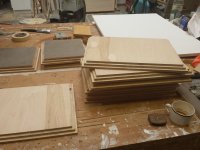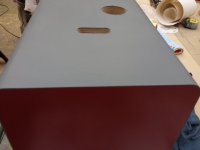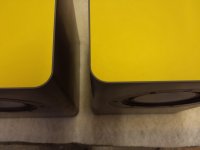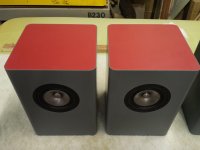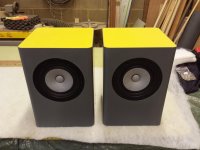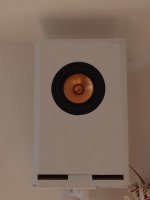Intermantas,
The answer is I don't know yet (see post 12). The 10.2' s have been superseded in any event. The 12's are now really opening up - we have about 400 hours on them (not including break in). We're very pleased with both builds. Warren and Shane (Shane)
The answer is I don't know yet (see post 12). The 10.2' s have been superseded in any event. The 12's are now really opening up - we have about 400 hours on them (not including break in). We're very pleased with both builds. Warren and Shane (Shane)
Double Rebated panels
I used two 8mm rebates on the panels to increase the effective glueing area, that is given the rounding required for the design I would have lost too much of the join if I had used butt joints or mitres. It was a bit tricky because it meant spending a lot of time setting up two old spindle moulders to a level of accuracy never attempted before. Not good in a shared workshop where there are only two spindle moulders.
The boxes then fit together like a kind of a puzzle but they did end up with the correct internal area and the rebates fitted together without any gaps.
I used two 8mm rebates on the panels to increase the effective glueing area, that is given the rounding required for the design I would have lost too much of the join if I had used butt joints or mitres. It was a bit tricky because it meant spending a lot of time setting up two old spindle moulders to a level of accuracy never attempted before. Not good in a shared workshop where there are only two spindle moulders.
The boxes then fit together like a kind of a puzzle but they did end up with the correct internal area and the rebates fitted together without any gaps.
Attachments
Now that's my kind of workbench, including the Dlugos sized espresso(?) mug
As to the earlier question 10s vs 12P - I think it's safe to say the older 10.2 was certainly capable of much deeper bass in the same sized box as the 12P, and frankly, for my money (by which I really mean the required enclosure size), I'd personally gladly sacrifice the 12P's extra sensitivity in favour of what both the new 10s do so well
As to the earlier question 10s vs 12P - I think it's safe to say the older 10.2 was certainly capable of much deeper bass in the same sized box as the 12P, and frankly, for my money (by which I really mean the required enclosure size), I'd personally gladly sacrifice the 12P's extra sensitivity in favour of what both the new 10s do so well
I'd personally gladly sacrifice the 12P's extra sensitivity in favour of what both the new 10s do so well
By my measures that sensitivity difference is less than a dB A10p vrs A10p
dave
nicely done, Cabinetmaker, so many ways to skin a cat. Your double rebate solution to achieve the req'd round-over is a good one !
Thank you Doorman. Design is important and so too is how a thing becomes physically manifested. It's best when both work together.
Shane and Warren (Warren)
Shane and Warren (Warren)
What I mean by the above vague statement is that we have spent a long time trying to get these right and there have been quite a few hiccups on the way. The plan was always to make the best physical box we could (within reason). We have made enclosures in the past that despite having a good design (on paper), ended up sounded disappointing, and the reason was that that we simply didn't spend the time to get the basics right when making them. Much of the (long..) time spent on these boxes was on how to get the making right.
For example there is a seamless join on each box where each rubber meets itself after it has been wrapped around the enclosure, but getting this one detail right was almost enough to make us give up on the entire project. The join is placed between the ports at the back and is now only visible after some close inspection (as it should be), but getting it like this was a trial and error and back to the drawing board nightmare...
For example there is a seamless join on each box where each rubber meets itself after it has been wrapped around the enclosure, but getting this one detail right was almost enough to make us give up on the entire project. The join is placed between the ports at the back and is now only visible after some close inspection (as it should be), but getting it like this was a trial and error and back to the drawing board nightmare...
Good listening 

 ...thanks sharing/posting very nice work. To reach that precision appearance level guess myself had to make ten or more trial and error boxes.
...thanks sharing/posting very nice work. To reach that precision appearance level guess myself had to make ten or more trial and error boxes.


 ...thanks sharing/posting very nice work. To reach that precision appearance level guess myself had to make ten or more trial and error boxes.
...thanks sharing/posting very nice work. To reach that precision appearance level guess myself had to make ten or more trial and error boxes.Thanks for your kind words!
Actually the process has been more than making test boxes, there have been kitchen doors, floors, cabinets and counters etc, made with rubber, and all helping build a knowledge and confidence in working the material.
Then there have been years designing and making all sorts of bespoke furniture.
We also set up rigs to test materials, working methods, tools, practicability, robustness, and every variable we thought would be important to achieving the best result.
We needed to understand the principles of loudspeaker design, learning to use programs and measuring.
Finally, although we have put this work in, we are confident that we still (as is evident from our postings..) and always will, have a lot to learn.
Actually the process has been more than making test boxes, there have been kitchen doors, floors, cabinets and counters etc, made with rubber, and all helping build a knowledge and confidence in working the material.
Then there have been years designing and making all sorts of bespoke furniture.
We also set up rigs to test materials, working methods, tools, practicability, robustness, and every variable we thought would be important to achieving the best result.
We needed to understand the principles of loudspeaker design, learning to use programs and measuring.
Finally, although we have put this work in, we are confident that we still (as is evident from our postings..) and always will, have a lot to learn.
I love the look of these speakers - that rubber material especially. I've just finished a pair of Alpair 10.3's in one of the CGR ported boxes. I wanted a non-wood appearance and eventually decided on using a gloss white car vinyl 'wrap'. However, the covering is actually very thin (I'm surprised its durable enough for a car wrap), the wood grain shows through and my finishing is very average. End result - they look pretty bad.
Therefore I'm looking at other options and that rubber looks great (particularly the matt look) - can you reveal a little more about it, where you got it etc?
Therefore I'm looking at other options and that rubber looks great (particularly the matt look) - can you reveal a little more about it, where you got it etc?
Attachments
- Status
- Not open for further replies.
- Home
- Loudspeakers
- Full Range
- 12P reflex - my first build!
